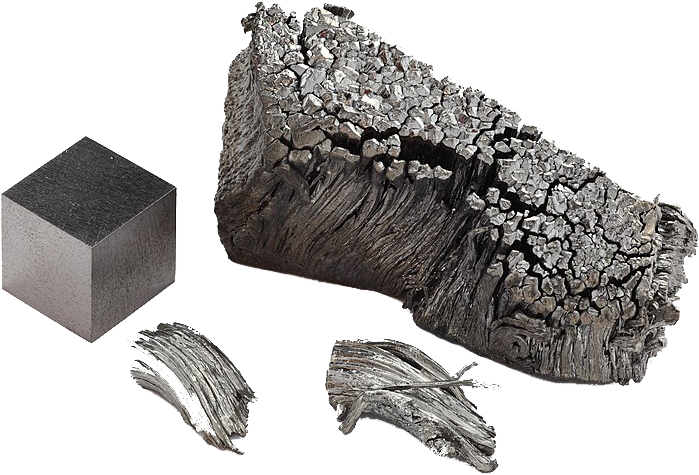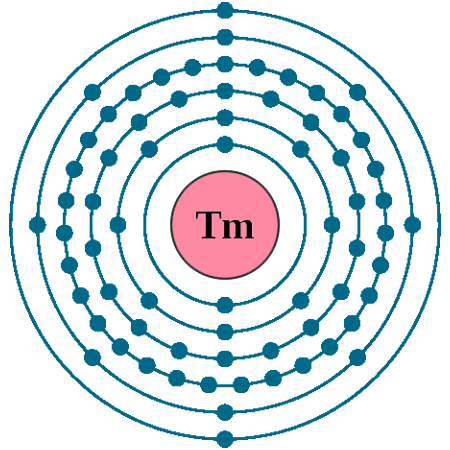69 Tm (Thulium)


Identity
CAS Number: CAS7440-30-4
CID Number: CID23961
DOT Numbers: 3089
CONTENT INDEX
Basic Properties of Thulium
Pronunciation: Thew-Lee-am
Appearance: Silvery gray, soft, malleable, and ductile, and can be cut with Knife.
Mass Number: 168
Standard Atomic weight: 168.934 g/mol
Atomic number (Z): 69
Electrons: 69
Protons: 69
Neutrons: 99
Period: 6
Block: f
Element category: Lanthanide
Electrons per shell: K2, L8, M18, N31, O8, P2
Electron configuration: 1s22s22p63s23p63d104s24p64d105s25p64f136s2

Thermal Properties of Thulium
Phase: Solid
Melting point: 1818 K (1545 oC, 2813 oF)
Boiling point: 2223 K (1950 oC, 3542 oF)
Fusion heat: 16.84 kJ/mol
Vaporization heat: 191 kJ/mol
Molar heat capacity: 27.03 J/(mol.K)
Thermal expansion: poly: 13.3 μm/(m∙K)
Thermal conductivity: 16.9 W/(m∙K)
Neel Point: 56 K
Electrical properties of Thulium
Electrical conductivity: 1.4×106
sElectrical resistivity: poly: 676 nΩ∙m
sElectrical type: Conductor
Curie point: 25 K
Magnetic Properties of Thulium
sMagnetic type: Paramagnetic (Above 56 K), Antiferromagnetic ( Between 32 K and 56 K), Ferromagnetic (Below 32 K)
Magnetic susceptibility (xmol): +25,500×10-6 cm3
Volume magnetic susceptibility: 0.0185488
Mass magnetic susceptibility: 1990×10-9 m3/kg
Molar magnetic susceptibility: 336.179×10-9 m3/mol
Physical Properties of Thulium
Density: 9.32 g/cm3 (In solid) 8.56 g/cm3 (In Liquid)
Molar volume: m3/mol
Young’s modulus: 74 GPa
Shear modulus: 30.5 GPa
Mohs Hardness: 1.77
Bulk modulus: 44.5 GPa
Poisson ratio: 0.213
Vicker hardness: 470-650 MPa
Brinell hardness: 470-900 MPa
Atomic Properties of Thulium
Oxidation states: 2, 3
Valence Electrons: 4f13 6s2
Ion charge: Tm3+
Ionization energies: 1st: 596.7 kJ.mol 2nd: 1160 kJ/mol 3rd: 2285 kJ/mol
Ionic radius: 86.9 pm
Atomic radius: 227 pm (Van der Waals)
Covalent radius: 190±10 pm
Filling Orbital: 4f13
Crystal structure: Hexagonal close-packed
Lattice angles: π/2, π/2, π/3
Lattice constant: 353.75, 353.75, 555.46 pm
Grid parameters: a=3.540 Å, c=5.56 Å
Attitude c/a: 1.570
Space Group Name: P63/mmc
Space Group Number: 194

Reactivity of Thulium
Electronegativity: pauling scale: 1.25
Valence: 3
Electron affinity: 50 kJ/mol
Nuclear Properties of Thulium
Half Life: Stable (Infinity)
Lifetime: Stable (Infinity)
Quantum Number: 2F7/2
Neutron cross section (Brans): 105
Neutron Mass Absorption: 0.025
Isotopes: 167tm 168Tm 169Tm 170Tm 171tm
| Isotope | Abundance (%) | Atomic Mass g/mol | Half Life (t1/2) |
| 167Tm | Syn | – | 9.25 d |
| 168Tm | Syn | – | 93.1 d |
| 169Tm | 100 | 168.934 | Stable |
| 170Tm | Syn | – | 128.6 d |
| 171Tm | Syn | – | 1.92 y |
Chemical Reactions
The metal tarnishes slowly in air and burns readily at 150 oC to form Thulium (lll) oxide:
4 Tm + 3 O2 → 2 Tm2O3
Reacts slowly with cold water and rapidly with hot water (form Thulium hydroxide and hydrogen gas):
2 Tm (s) + 6 H2O (l) → 2 Tm(OH)3 (aq) + 3 H2 (g)
The metal reacts with all Halogens to form Thulium (lll) halides:
2 Tm (s) + 3 F2 (g) → 2 TmF3 (s) [white] (Thulium (lll) fluoride)
2 Tm (s) + 3 Cl2 (g) → 2 TmCl3 (s) [yellow] (Thulium (lll) chloride)
2 Tm (s) + 3 Br2 (g) → 2 TmBr3 (s) [white] (Thulium (lll) bromide)
2 Tm (s) + 3 I2 (g) → 2 TmI3 (s) [yellow] (Thulium (lll) iodide)
Dissolves readily in dilute sulfuric acid to form Solutions containing Thulium (lll) ions (Pale green):
2 Tm (s) + 3 H2SO4 (aq) → 2 Tm3+ (aq) + 3 SO42− (aq) + 3 H2 (g)
Thulium History
Naming: After Thule (A mythical region in Scandinavia)
Discovery: Per Teodor Cleve (1879)
Thulium Uses
Thulium has been used to create lasers.
When irradiated in a nuclear reactor, thulium produces an isotope 169Tm that emits x-rays.
This Radioactive thulium isotope is used to make a lightweight, portable x-ray machines for medical use.
Isotope 171Tm is potentially useful as an energy source.
Natural thuliums also has a potential use in ceramic magnetic material (Ferrites), which is used in microwave equipment.
Biological role: It is Low-toxic, But it should be handled with care.
Abundance of Thulium
Thulium is found in ores are monazite and bastnasite, and commercially obtained from monazite, which contains about ~ 0.007%.
It is extracted by ion exchange and solvent extraction.
Thulium metal can be obtained by reducing the oxide with lanthanum, or reducing the anhydrous fluoride with calcium.
It is the 2nd rarest lanthanide element, after promethium.
Annual world production of thulium oxide is around 50 tons.
1×10-8% (In Universe)
2.9×10-6% (In Meteorites)
2×10-8% (In Sun)
0.000045% (In Earth’s Crust)
2×10-11% (In Oceans)
World’s Top 3 producers
1) China
2) Russia
3) Malaysia
World’s Top 3 Reserve holders
1) China
2) CIS Countries (inc. Russia)
3) USA
#thulium


